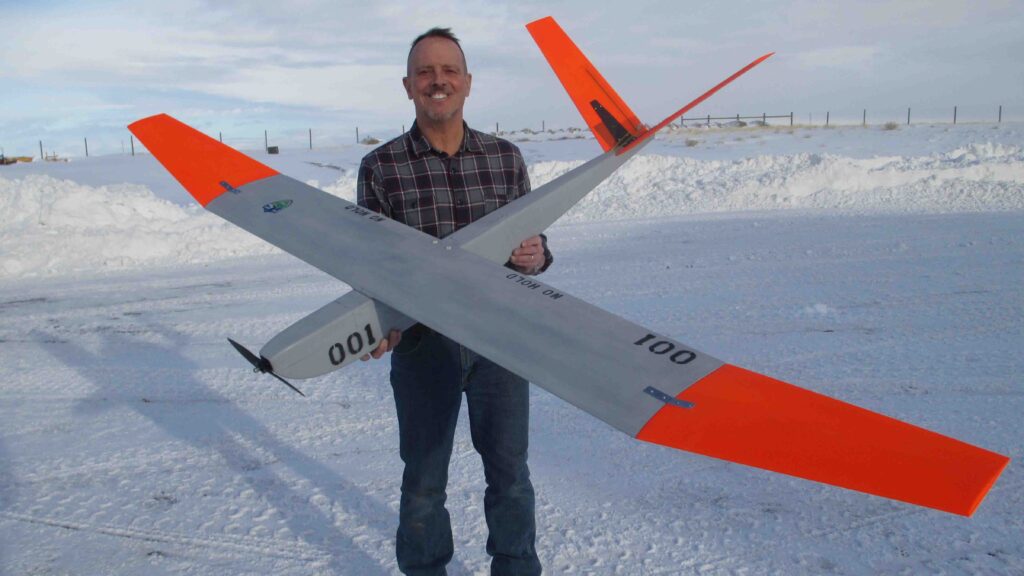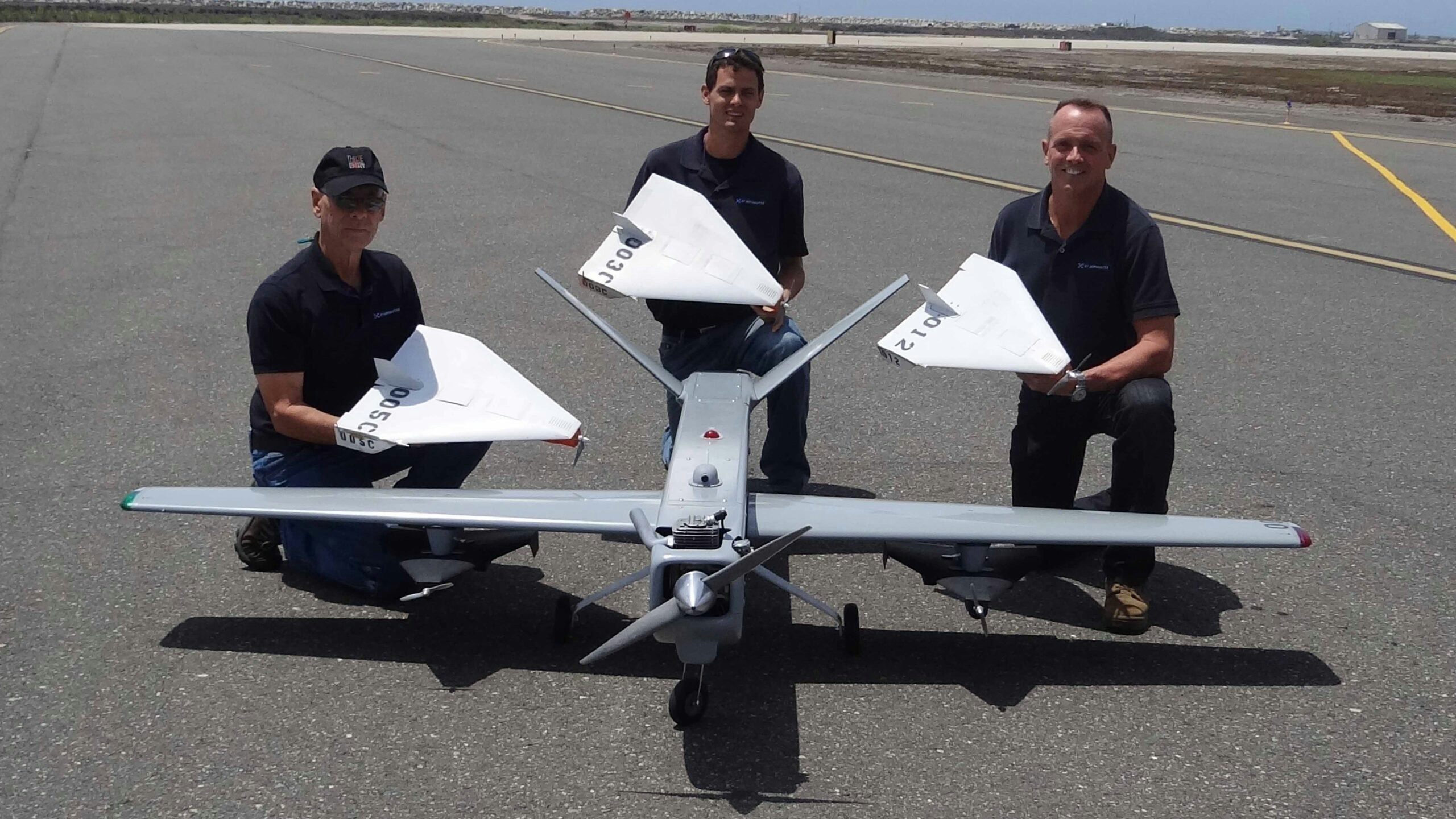Tom Rullman, president and CEO of Powell-based GT Aeronautics, flew light attack aircraft in the Navy. He is a graduate of the Naval Fighter Weapons School, popularly known as Top Gun, and he has over 300 carrier landings and 30,000 military and commercial flight hours.
After he got out of the Navy, he noticed the Department of Defense (DOD) really wasn’t pursuing unmanned military aircraft, but Rullman saw the potential. He started pondering an idea for a different kind of unmanned aircraft system, which most people call drones.
“What happens if I design weaponized unmanned aircraft that are similar to the light attack aircraft that I flew off the aircraft carriers?” Rullman told Cowboy State Daily.
So, he began designing the Bandit, an unmanned aircraft, which are sometimes called drones, that is capable of launching smaller aircraft — affectionately called Banditos — which then seek out enemy drones and blow them out of the sky.
Military Drone
GT Aeronautics is run out of a hangar at the Powell Municipal Airport, where the company moved in 2016. At the facility, the unmanned aerial vehicles are designed, manufactured with processes Rullman developed, and then sent out into the field for testing.
The company started in 1998, designing radio controlled composite aircraft, which are aircraft with other aircraft attached that can be launched and flown separately. This was long before people were buzzing around quadcopters to take aerial photographs.
Rullman has a degree in aeronautical engineering from Ohio State University, and he started using his knowledge of aircraft design to build the type of unmanned military aircraft he believed possible.



Paper Airplane
From that vision came the Bandit, which has a 17-foot wingspan. He has a smaller version, about half the size, called the Tacamo. From the Bandit and Tacamo, he can launch the little Banditos, which are based on a simple concept.
“They came from a paper airplane,” Rullman said.
With the Bandit and Tacamo, Rullman said he followed a “KISS” principle — Keep It Simple Stupid.
“There’s nothing glitzy about it. They’re designed to fly well, carry payloads, fly for long periods, and do it all efficiently,” Rullman said.
At the time he developed the aircraft, no one was thinking of putting ordinance on these types of unmanned planes.
“I was laughed at. People said you’re out of your mind,” Rullman said.

Micro Air Vehicle
In 2006, he started going after his first DOD contract for the development of the Battlefield Airman Targeting Micro Air Vehicle (BATMAV). The goal of the program was to develop a small aircraft that could be launched by hand, find targets from the air, and send the enemy locations back to the commanders. The military could then send in artillery or airstrikes to take out the targets.
“That’s how the Bandito got started,” Rullman said.
When he sent in the concept and information on the Bandito, Rullman was selected to come down for a fly off at Eglin Air Force Base in Florida.
“They really liked what they saw,” Rullman said
First-Place Loser
The problem was, GT Aeronautics didn’t have an aircraft that could actually fly. They were still in development when the fly-off was announced. But Rullman wasn’t going to pass up the opportunity to compete with six other companies for a $40 million contract. So he packed up a model of his project so the military officials could at least see what the company was working on, even if it didn’t fly.
“I’ll be damned if I wasn’t going to go down there and show them what we had. And they loved it,” Rullman said.
He was then called down to Wright-Patterson Air Force Base to debrief on the project. Rullman said he was later told that if the aircraft could have flown, GT Aeronautics would have won that contract.
“We were the first-place loser,” Rullman said, reflecting a bit of pride and optimism.
Ground Control
Rullman competed a few years later at the Naval Air Weapons Station in China Lake against the company that won the $40 million contract. By that point, the Bandito was flying, and they were launching from a rail mounted on top of a ground control station Rullman had designed for that purpose. The idea being, the military could roll the ground control station out where it needed to find targets, and launch the little airplanes to go find them.
The competing company, however, didn’t perform well, even though they had a $40 million DOD contract for their project.
“They couldn’t fly because it was too windy, and we were flying in 40-mile per hour winds,” Rullman said.
Absolutely Screaming
Rullman’s original vision, though, was to have an air-launched aircraft. The Bandito could only fly for about 15-minutes. With the Bandit, which can fly for four or five hours, it would have a lot longer range in combat.
The Bandito can fly at 200 miles per hour in a dive. So launched as a munition — meaning it can blow stuff up — from the Tacamo or Bandit, the system could hit targets far away and very quickly.
“The little Bandito is absolutely screaming,” Rullman said.
It also doesn’t show up well on radar. Parts of the Bandito are classified because of its stealth capabilities, Rullman said.
Hunter Killer
Rullman has continued to pursue DOD contracts. This past week he sent designs to Special Operations Command for a concept of a hunter-killer unmanned aerial vehicle (UAV), which is what the Tacamo and Bandit are.
“The Bandit and Tacamo can actually kill the target once they find the target. They carry weapons on board. They hunt for targets, and they kill the target,” Rullman said.
This is as opposed to using the UAV for reconnaissance – meaning looking for stuff to blow up — passing that information to an operator, and then the operator calling an airstrike, like the ground-launched Bandito.
Rullman said the reason the concept came up again is because the Marine Corp is looking at utilizing small, unmanned aerial vehicles that carry munitions onboard.
The concept of the Hunter-Killer UAV was first published in 2007, Rullman said, in the Air Force 20-year master plan, and the Bandit with the Banditos were listed in it. However, they never pursued it.
Rullman is hoping that’ll change, and the use of off-the-shelf, modified drones in the war in Ukraine is raising awareness of just how capable UAVs are in the field.
Recently, GT Aeronautics successfully tested rocket launchers on the Tacamo.
Other Uses
Besides blowing up enemy targets, Rullman’s designs have other potential purposes.
Rullman designed an electric UAV that flies for a couple hours, cruising at 35 mph and up to 10,000 feet. It’s been helping the Park County Weed and Pest office look for leafy spurge, an invasive species of plant. Finding it by ground requires miles of walking, whereas a UAV can spot its yellow flowers from the air and cover miles of territory per day.
He’s also working with search and rescue operations. The Tacamo can not only locate people lost in the wilderness, it can be fitted with pods that can be dropped to people in need of rescue. The pods can hold food, water, radios and solar blankets.
In the meantime, Rullman continues to develop ways for his designs to be used in defense operations.
He’s also in talks with a company that might buy GT Aeronautics. They would keep Rullman on board, and he said he’d be able to hire 10 people overnight.
“We’re entertaining that possibility right now. We’ll see where it’s going to go,” Rullman said.





